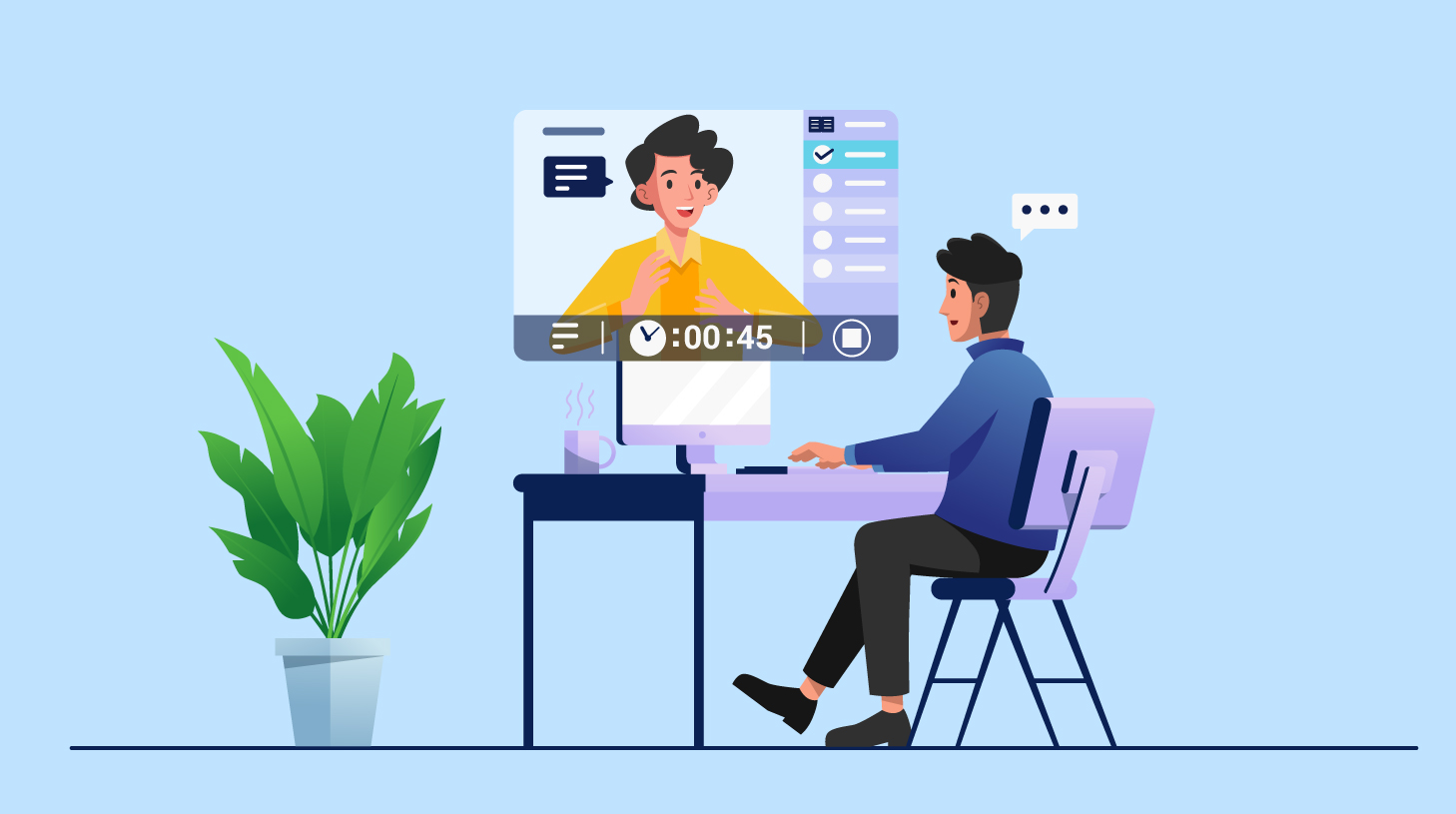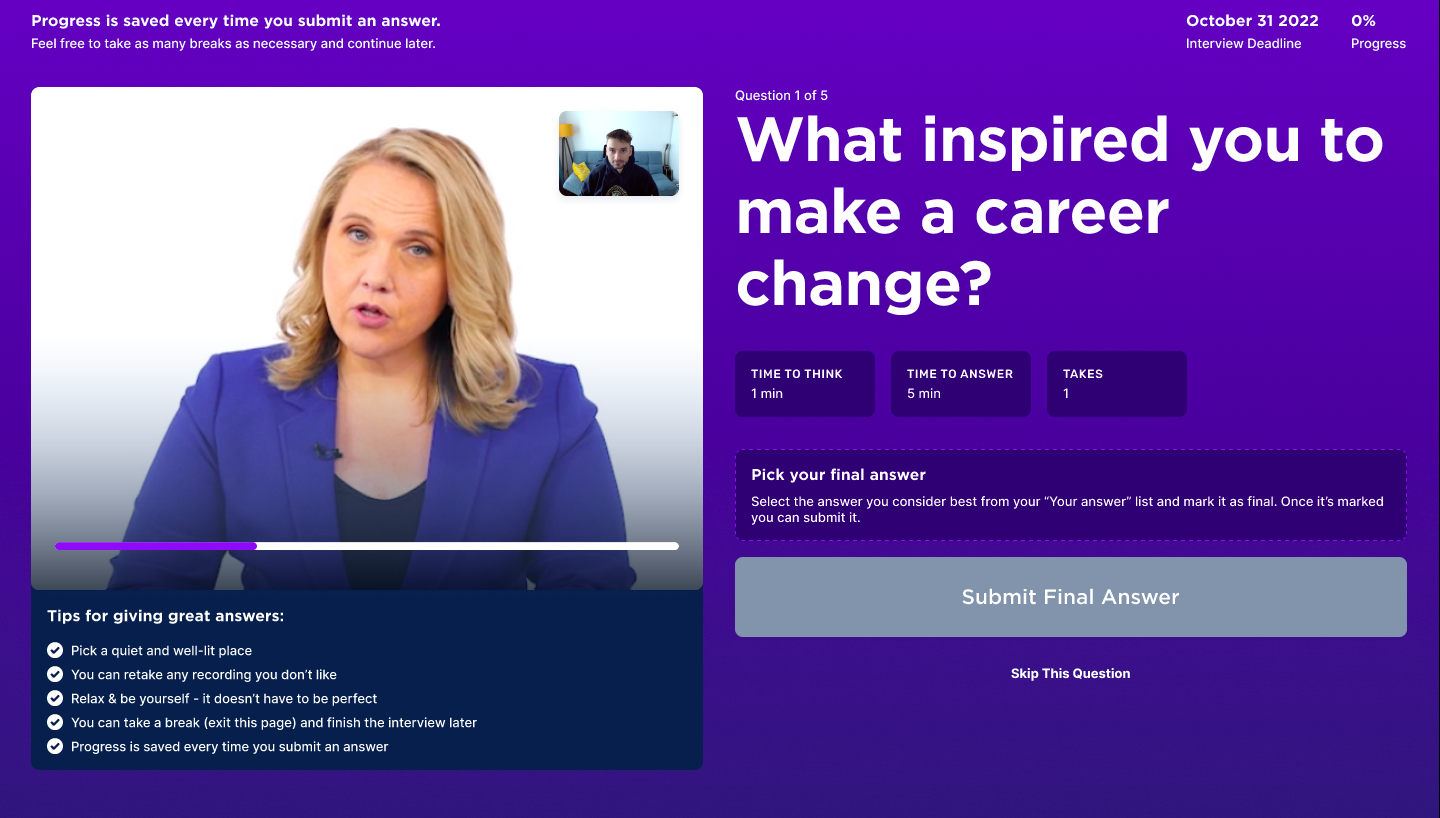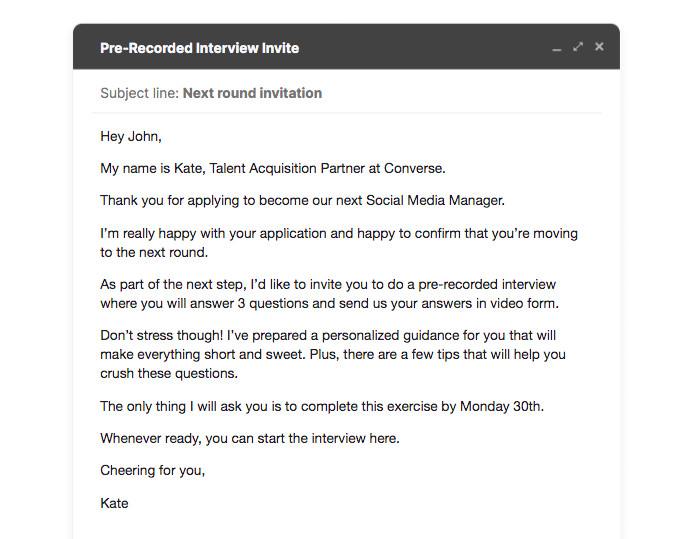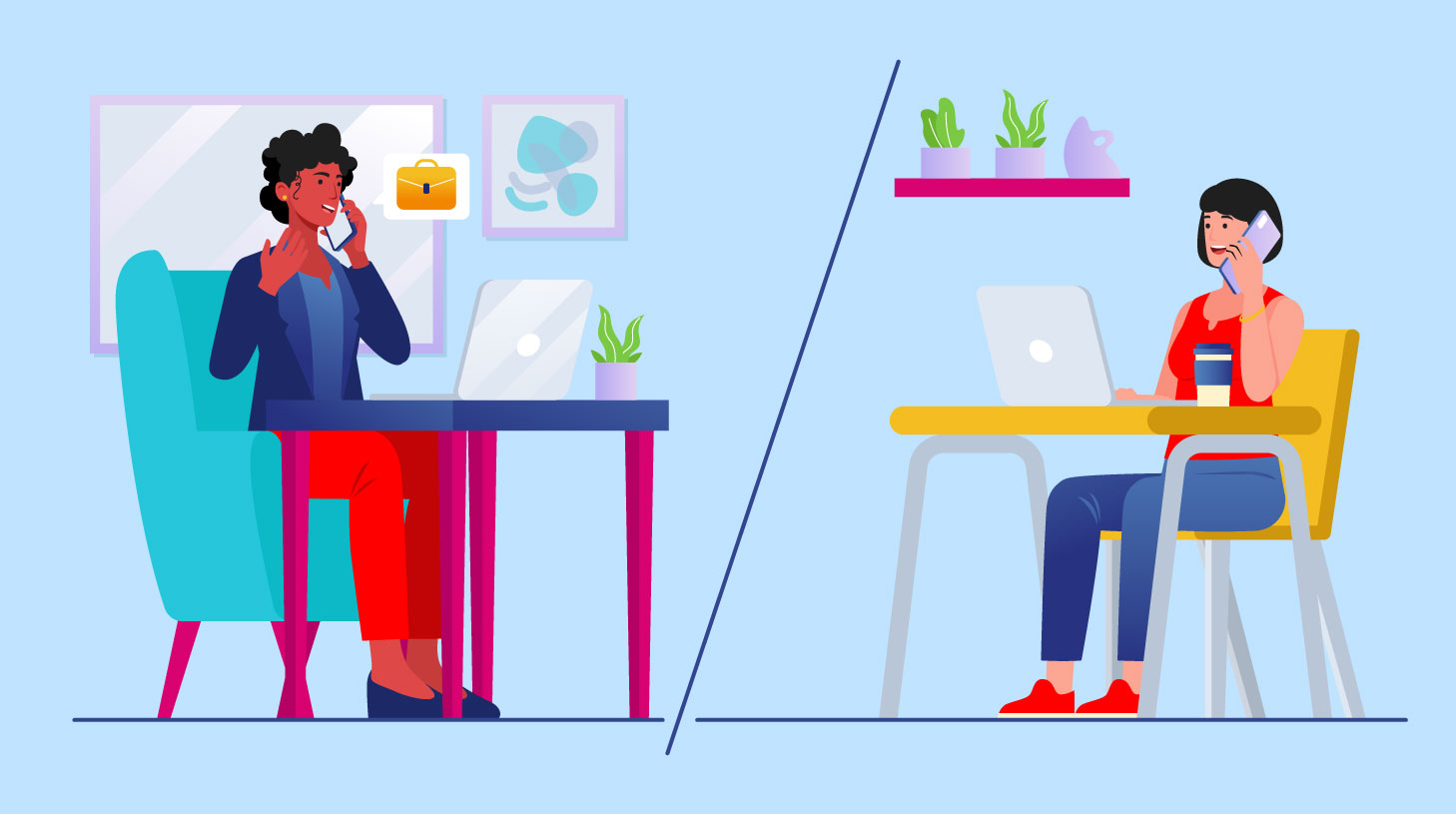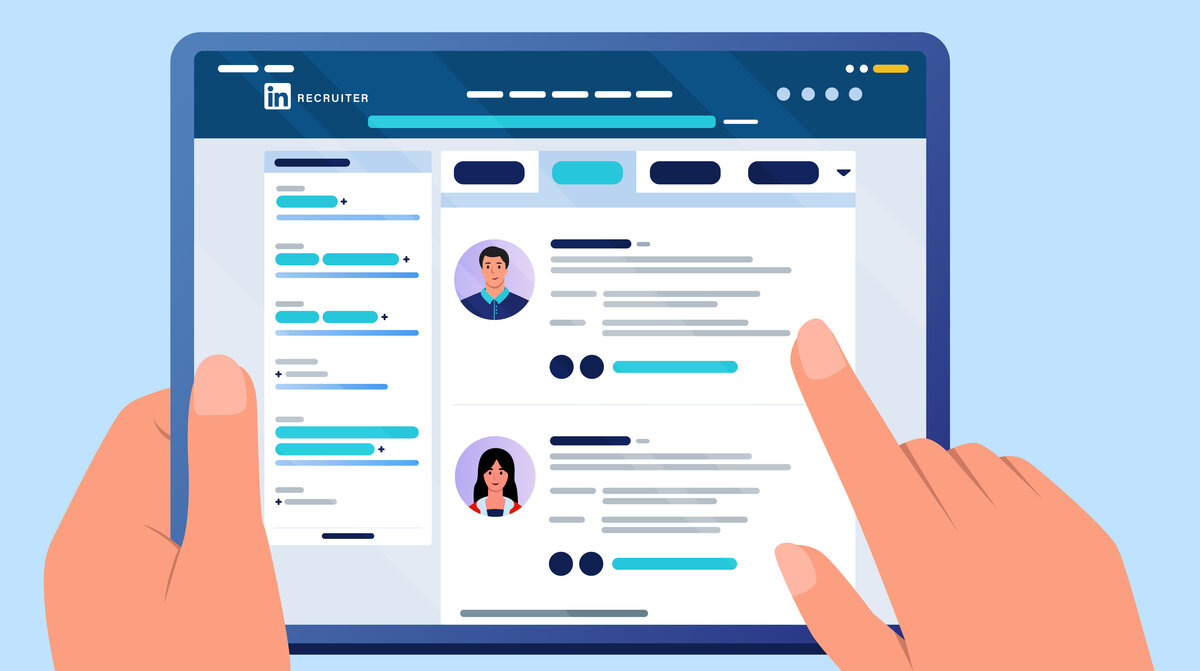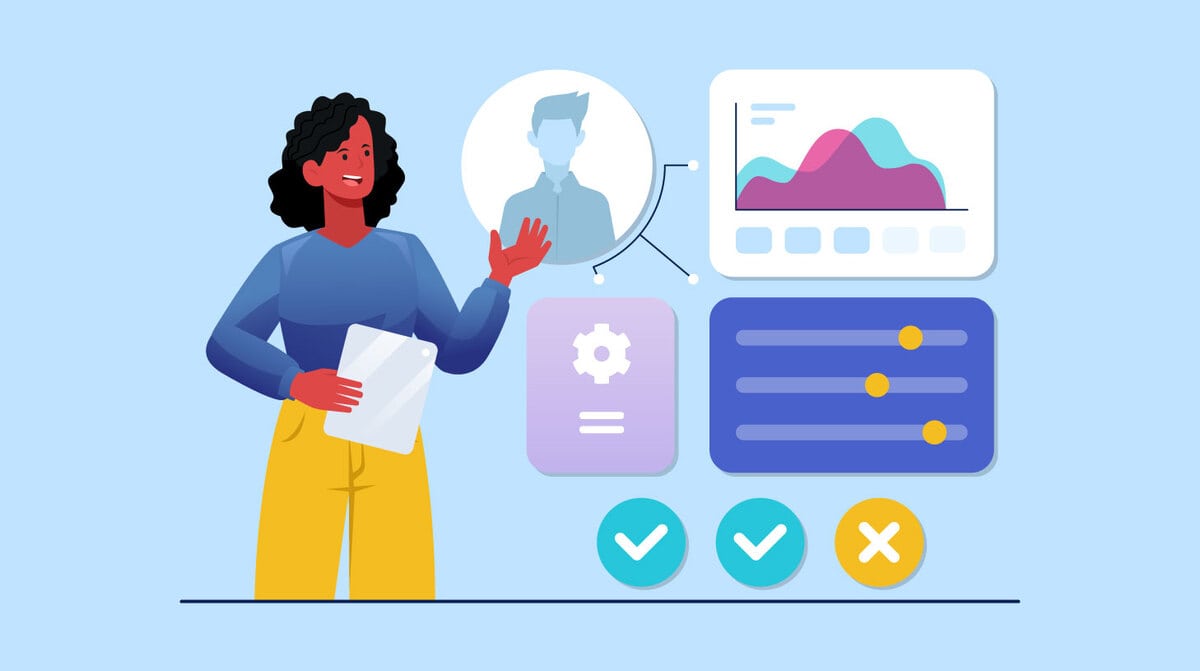As a recruiter, you probably have your reservations about one-way video interviews.
You may feel they ruin candidate experience. Because of the low candidate engagement, you end up losing the best candidates. They worsen the employer-employee dynamic and dehumanize hiring.
And yet, you’re being pushed to find the best talent and hire fast.
What if I told you that one-way video interview is precisely the secret tactic to:
- speed up the hiring without sacrificing human element,
- solidify your employer brand & provide great candidate experience, and
- speak to the best candidates regularly & waste less time?
In this article, you’ll learn how to execute one-way video interviews WITHOUT compromising the human aspect of it or losing candidates in the process.
Let’s start with the basics. 🚀
What Is a One-Way Video Interview?
A one-way video interview (also known as pre-recorded or asynchronous interview) is a job interview format where a candidate is asked to answer several questions in video form for the hiring manager or HR to view later.
Unlike two-way video interviews that make use of platforms such as Google Meet, Zoom or Skype, pre-recorded video interviews do not involve real-time communication between the candidate and the interviewer and take place on a platform provided by the employer.
Recruiters use one-way video interviews in the early, pre-screening stages of the hiring process to get to know the person behind the CV a little better before inviting them to the first round of face-to-face interviews.
One-Way Video Interview Guide for Recruiters & Hiring Managers
All hiring managers know how difficult it is to find THE candidate, and it would be silly to lose the right one by choosing the wrong interview format.
I’d hate to serve you a nothingburger, so here’s what one-way video interviews can do for you (with TESTED examples and candidate stories):
Help connect with candidates across different time zones
One-way video interviews save loads of time as there’s no need to coordinate screening phone calls or live video interviews so early in the process. This is rather obvious.
Here’s something that’s special. I have this rule that for every position, I need to have 1 or 2 candidates in the next round who are not best ‘on paper’, but who might surprise me. In 80% of cases, it didn’t work. But for 3 of them it did. One got the job, one I recommended to a friend where she was hired, whereas the third one lost on details, but I’m confident we’ll work one day together.
Today, pre-recorded interviews help me improve that 80% accuracy as I could give these people an opportunity to stand out. And not just them, because I have a legit filter that helps with screening.
- Make it easier to sync with candidates who are already employed
To come in for a first-round interview or to answer a phone call, candidates who are already employed need to squeeze it into their lunch break or take a day off. I like to send them a link to a one-way video interview to eliminate this inconvenience.
Help me fast track hiring and meet more candidates
We’re all hiring remotely, which means there are SO MANY interesting candidates out there.
Imagine getting 200+ applications. Let’s say there are 30 candidates we want to invite for a first-round interview. That can easily take two weeks – we’d spend roughly a week on pre-screening calls and scheduling and then 30 hours in the actual interviews = at least 2 weeks of a full calendar and zero time to do anything else.
Instead, with one-way video interview software, it takes us a couple of minutes to send out the questions. Once the videos arrive, we need a few hours to watch them. Tons of time saved. We win. 🙂
Allow me to pre-screen for what matters early in the process
Let’s say you’re interviewing a non-native speaker for a Content Writer role. You’d be interested in the candidates’ language proficiency and fluency as much as their technical expertise.
A one-way video interview lets you hear what they sound like and makes it super easy to decide who to eliminate and who to move forward.
This could be also beneficial for any client-facing role because you can see how they speak and “feel their energy”.
For example – I like to ask a BDR to tell me about their hobbies. Just this single question can tell a lot about how passionate they are, how they talk and how they’re “selling” their hobby.
And just to give some context, I’m not sending 10+ questions, but only 3 simple ones that actually tell A LOT. Simple for the candidate, simple for me.
Make it super easy to scan for soft skills
As a wise man once said, hard skills get you hired, soft skills get you fired. One-way video interviews provide tons of information on a candidate compared to phone or first-round interviews. Here’s why:
- The candidate is more relaxed as there’s no pressure of being analyzed in real time.
- You can rewatch their presentation and check for subtle clues like communication style, motivation, and enthusiasm.
- You can check if the candidate has taken the time to learn about your organization and role.
A Step-by-Step Guide for Pre-Recorded Video Interviews
For one-way video interviews to do what they’re supposed to do – minimize scut work, save time and help you shortlist the best candidates – your main mission is to create a superb candidate experience.
Here’s a step-by-step guide that you can use.
Step 1 – Choose the right interview questions
First, don’t ask too many questions. You will have low engagement.
Btw, this takes me back to when I was looking for my first job and tried to fill in this Nike form of 20+ questions. Ultimately, I gave up…
Instead, ask between 3 and 5 questions only.
For example, let’s pretend we’re hiring a YouTube Manager. Here are the questions you and I could ask:
- Tell me a little about you and what’s your story?
- In your opinion, what are the steps you need to take to create a viral YouTube video?
- What do you do when you’re not building YouTube channels?
With this classic “Tell me about yourself”-style question, we’re looking for the candidate able to give us the highlights of their career in a sharp and relevant way for the role they are applying for?
With the second one, the goal is to demonstrate the basic understanding behind the YouTube challenge. It’s all about creating quality videos, but then knowing how to distribute them and get attention. Candidates that don’t mention distribution are not the right candidates to spend time on.
Finally, the third question is something they should feel super comfortable about. With this one, we’re trying to check their energy and vibe on video. If they are going to be shooting videos, they need to be comfortable in front of the camera. Precisely why we want to ask them a question like this.
Pro tip: Lead by example. Don’t be a lazy bum – record a video of yourself asking the questions (rather than have them as plain text). How do you expect your candidates to be natural on video if you’re not ready to get your own hands dirty?
Step 2 – Give candidates context & make the process human
Beside the actual questions, you might also want to record a short introduction video about yourself, the company and the position.
This is the best 10-minute investment you can make – helps the candidate get a general feel for the company and humanizes the whole process. Plus, if I explain the role and give a company intro here, I won’t have to repeat myself at the beginning of every single interview.
Here’s an example:
Step 3 – Make it easy for candidates to record
Since there’s no real-time interaction, it would be smart to make the entire process as frictionless as you can. Also, some candidates may be doing a one-way video interview for the first time. You don’t want them to drop off just because they were struggling with your instructions.
Here are a few tips to kill friction:
- Ask 3-5 questions only
- Give candidates the ability to do test recordings
- Make sure it’s clear if they have unlimited takes or not
- Make sure there’s a time limit for each answer
- Include a timer so that they know how much time they have left
As a little bonus, I always like to include a video of me explaining that I don’t need them to be chasing perfection and send me the perfect video. Here’s how:
Step 4 – Choose a reliable software to back you up
Your one-way video interview software should have all the features and options outlined in the previous section.
- Attractive user interface – Most of your candidates will be Millenials and Gen Z, which means high expectations when it comes to user-friendliness, no friction and quick in-app guidance tips to make everything smooth.
- Candidate-focused features – This means having test runs prior to sending their answers, the ability to do it from the phone or laptop, etc.
- Actionable feedback for you – When a candidate leaves a review online, that’s for branding purposes. But having a quick way to send your their $0.02 about your hiring and pre-recorded experience can tell how to improve.
- Privacy concerns – If a candidate wants to have their data removed after the hiring process finishes or after a certain period of time, they should be able to do that (let’s all take a moment to remember Zoom’s security issues).
- Customization – A question like “Tell me about yourself” might require a one-minute answer, but what if I ask the candidates to tell me about their top 3 achievements? Being able to customize things in the backend is super handy, so choose a one-way video interview software with plenty of customization.
Teaser trailer for the software that has it all:
Step 5 – Send personalized invitations
A little personalization goes A LONG WAY, especially when you’re asking job applicants to make some extra effort. That’s why personalized, warm email invites always do the trick for me. Here’s a free template that’s friendly and confidence-boosting.
Step 6 – Pick your A players & ALWAYS send rejection emails
Since the format of the interview is pretty structured (each candidate gets the same questions in the same order), you can also use the AI scores provided by the one-way video interview software as the foundation.
The key thing for a recruiter or hiring manager to do is to watch the recordings and see how candidates perform against your criteria. The best advice I can give you is to always have well-defined criteria that you can use to compare applicants.
For example, let’s go back to our YouTube Manager role. Here’s how I would evaluate:
- From 1 to 5, how relevant was their answer to the “tell me about you” question for the role itself?
- In their experience, did they mention working on all key tasks that we need them completing?
- While answering the hobby question, how was their energy? Were they funny and engaging since we’re looking for that type of personality? How’s their voice volume and content delivery throughout the video?
- How’s their English level?
Also, never be a ghoster 👻, por favor.
Especially not after the candidate has invested the time to do a pre-recorded interview. Provide honest and actionable feedback, whenever you can.
And honestly, if you’re not sending rejection emails regardless of the interview stage, I think you should be taxed. Fingers crossed that the good Gods of Internet bury you with severe tax penalties.
Here are some email rejection templates that provide value and constructive feedback (written by yours truly).
A Quick Recap
- A one-way video interview is not there to replace in-person interviews. You’ll use it in the pre-screening stages to decide which candidates to move forward (e.g. instead of the phone interview).
- It’s super important (and tricky) to provide a premium candidate experience. To get high reply rates, you need to invest time to personalize the process and make sure that the candidate feels as comfortable and confident as when ordering an Uber ride.
- All in all, pre-recorded interviews have helped me accomplish 3 huge things:
– meet my pre-screening goals and have great conversations later,
– become super efficient and cut my hiring times in half, and
– nail candidate experience using a new, yet exciting interview format. 💪
P.S. If you want to be a part of something B.I.G. and be among the first to try our new one-way video interview software in Beta, drop me an email at vuk@biginterview.com.-
